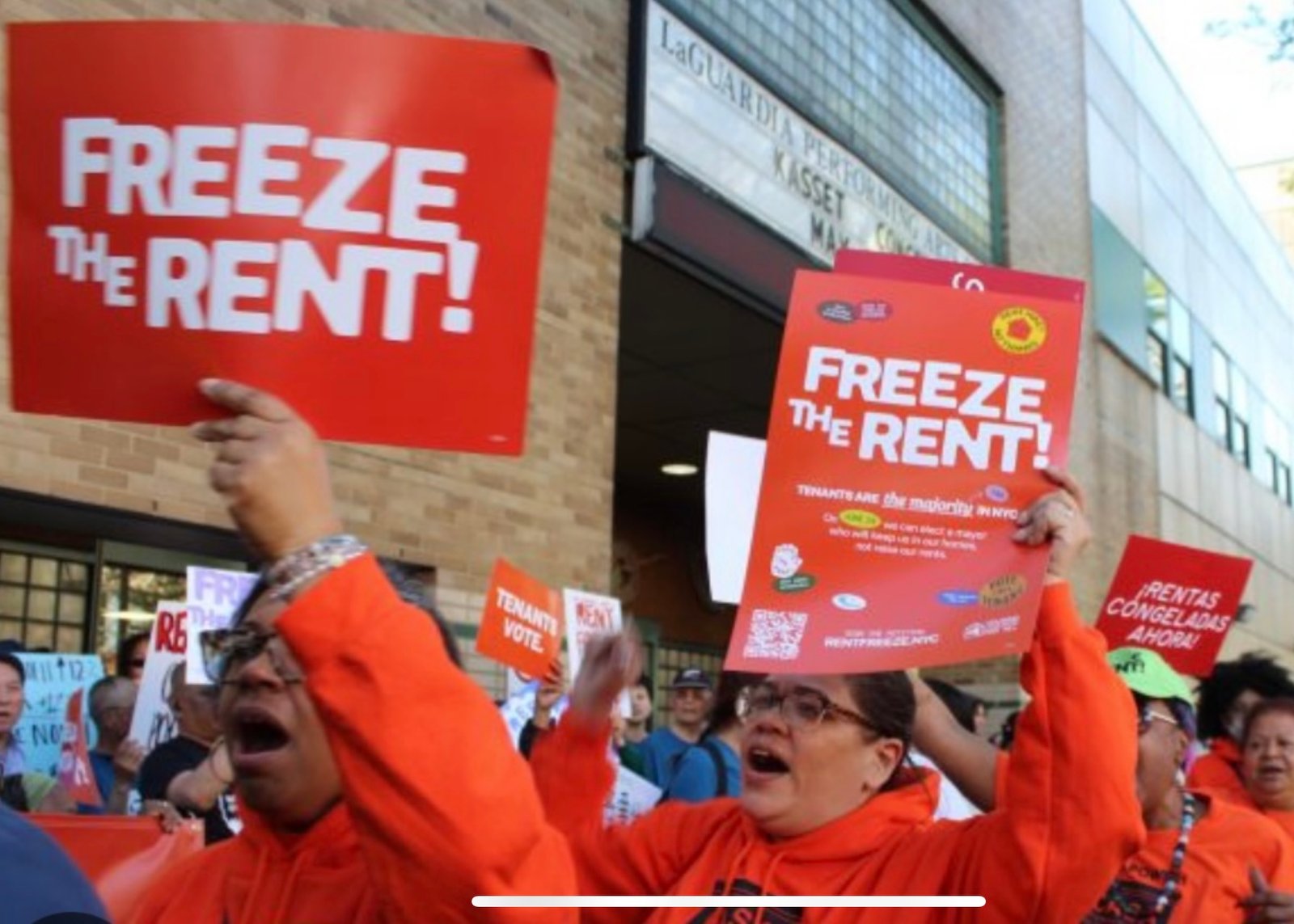Tenants and Landlords Clash Over the Future of Rent-Stabilized Housing Ahead of June 27 Decision NEW YORK — As New York City continues to grapple with a deepening housing and affordability crisis, the question dominating this year’s Rent Guidelines Board (RGB) vote is whether to raise rents for over two million tenants or implement a …
NYC Rent Freeze Debate Ignites as Board Prepares to Vote on Increases

Tenants and Landlords Clash Over the Future of Rent-Stabilized Housing Ahead of June 27 Decision

By Owens Harris,
Senior Reporter | Midtown Times | Published on June 5, 2025
NEW YORK — As New York City continues to grapple with a deepening housing and affordability crisis, the question dominating this year’s Rent Guidelines Board (RGB) vote is whether to raise rents for over two million tenants or implement a rent freeze.
On June 27, the RGB — a nine-member board appointed by the mayor — will determine rent adjustments for approximately 1 million rent-stabilized apartments. The board is weighing proposed hikes between 1.75% and 4.75% for one-year leases, and 3.75% to 7.75% for two-year leases, or the possibility of no increase at all — a decision tenants call a lifeline and landlords call a death spiral.
A City on Edge
Tenant groups, led by the New York State Tenant Bloc, have staged passionate protests, demanding a rent freeze as inflation squeezes household budgets. According to a poll by Data for Progress in April 2025, 78% of likely voters support a freeze, with bipartisan backing — 83% of Democrats and 63% of Republicans in agreement.
“The city runs on rent-stabilized tenants,” said Cea Weaver, director of the bloc. “A rent freeze isn’t just popular — it’s necessary.”
Rent-stabilized apartments make up nearly half of NYC’s rental units, with many occupied by low- to moderate-income families. The median income for these households is $60,000, and the average rent is $1,500. Advocates say rising grocery, utility, and healthcare costs leave little room for rent hikes.
Landlords Warn of Crisis
Property owners argue the 2019 Housing Stability and Tenant Protection Act (HSTPA) — signed by then-Gov. Andrew Cuomo significantly restricted their ability to recoup costs. With inflation driving up insurance, maintenance, and labor expenses, they claim small landlords are teetering on financial collapse.
Kenny Burgos, head of the New York Apartment Association, said the board must approve a 6.25% rent increase just to “stop the bleeding.”
“Freezing rents will accelerate the deterioration of thousands of buildings,” Burgos warned. “It’s irresponsible policy masquerading as compassion.”
Burgos added that RGB rent hikes are landlords’ only tool to keep up with soaring costs. If denied, “some owners will stop maintaining their buildings. Others may lose them altogether.”
Dividing the Mayoral Field
The rent freeze debate has also become a political flashpoint in the 2025 mayoral race.
Former Gov. Andrew Cuomo, now a leading candidate, opposes a freeze. His campaign’s largest donor, Housing For All PAC, is backed by real estate interests, including some landlords cited for property neglect. In a policy paper, Cuomo said, “If small landlords don’t receive cost-reflective increases, they won’t be able to maintain buildings.”
Current Mayor Eric Adams, running as an Independent, also opposes a freeze, warning that gas, insurance, and electricity don’t freeze either. “The cost of running a building doesn’t freeze,” he said.
In contrast, progressive Assembly Member Zohran Mamdani, polling in a close second, has vowed to freeze rents for his entire four-year term. Other Democratic hopefuls, including Comptroller Brad Lander, City Council Speaker Adrienne Adams, and State Sens. Zellnor Myrie and Jessica Ramos, all support at least a one-year freeze.
An Impossible Balancing Act?
Experts say the RGB’s task may be unworkable under current conditions. Mark A. Willis of the NYU Furman Center said the board’s mandate to protect tenants and preserve buildings is fundamentally at odds in an era of high inflation.
Willis cited RGB data showing owners’ operating costs rose 6.3% last year — including an 18.7% spike in insurance. Yet proposed rent hikes for one-year leases top out at 4.75%.
Without additional funding mechanisms, “the board can’t satisfy both sides,” said Willis. “You’re choosing between bad and worse.”
He highlighted roughly 200,000 rent-stabilized units — particularly in the Bronx — that are at risk of insolvency. In these buildings, costs have outpaced rent hikes every year since 2010.
Tenants: ‘We Need Relief’
Fitzroy Christian, a Bronx tenant since 1976, pays $1,031 for a two-bedroom apartment — a low rent by NYC standards. But his building has 39 open code violations, and he’s endured ceiling collapses, pest issues, and heating problems.
“A rent reduction is more appropriate, but a freeze would ease the trauma,” said Christian. He emphasized that many of his neighbors “are skipping meals or splitting medication doses to survive.”
In Chinatown, Yun Chen echoed his concerns. Though her rent is frozen under the city’s SCRIE program for seniors, she said others in her building pay $1,600 — yet the property has seen no meaningful upgrades since 2008.
“Only surface repairs have been made,” said Chen. “What are the landlords paying for?”
Transparency & Trust
Tenant advocates argue landlords often fail to reinvest increased rent revenue into property upkeep. Cea Weaver said owners should disclose their finances to the RGB — but few do. “If they truly can’t cover costs, show us the books.”
Some owners have shared their records with the press, showing declining net income post-2019. But Weaver remains skeptical, accusing many of gambling on risky investments and expecting tenants to bail them out.
“It’s not our job to cover landlords’ losses,” she said.
Programs That Work — But Don’t Reach All
NYC’s SCRIE and DRIE programs freeze rents for seniors and people with disabilities who qualify. These programs reimburse landlords through tax abatements, a win-win, say supporters.
However, many working- and middle-class tenants don’t qualify and still face crushing housing costs. Burgos said the answer lies in expanding these programs, not implementing a universal freeze.
Yet 170,000 rent-stabilized units are already protected under these exemptions — and another 100,000 tenants qualify but are not enrolled, he noted.
What’s at Stake
With NYC’s vacancy rate for rent-stabilized units at just 0.98%, preserving affordable housing is critical. Whether the RGB opts for a rent freeze, modest increases, or something in between, the outcome will shape the city’s housing landscape for years to come.
Tenants like Christian believe organizing is the only way forward: “We can only survive as a community,” he said. “When one of us suffers, it is a threat to all of us.”
The RGB will vote on June 27. Regardless of the outcome, it promises to be one of the most consequential housing decisions in recent city history.

The Midtown Times is committed to delivering accurate, timely, and comprehensive news to our readers.











